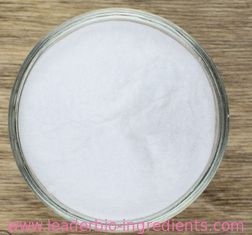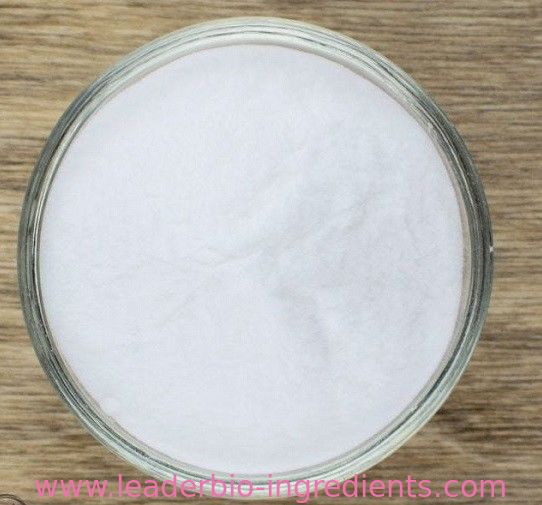
China Largest Factory Manufacturer GABA/4-Aminobutyric Acid CAS 56-12-2 For stock delivery
-
Purity99.9%
-
UseHealth Care
-
OriginChina
-
Package1KG/Tin 25KG/Drum*Carton
-
ManufacturerXI'AN LEADER BIOCHEMICAL ENGINEERING CO.,LTD
-
Place of OriginCHINA
-
Brand NameLeader
-
CertificationISO,GMP,SGS,HALA,KOSER,HACCP
-
Model NumberLD
-
Minimum Order Quantity25KGS
-
PriceNegotiate Depend on order quantity
-
Packaging Details25KG/Drum
-
Delivery Time2-3 working days
-
Payment TermsWestern Union, MoneyGram, T/T, L/C
-
Supply Ability10MTS/Month
China Largest Factory Manufacturer GABA/4-Aminobutyric Acid CAS 56-12-2 For stock delivery
| 4-Aminobutyric acid Usage And Synthesis |
| Description | 4-Aminobutyric acid (GABA) is the chief inhibitory neurotransmitter in the mammalian central nervous system. It plays a role in regulating neuronal excitability throughout the nervous system. In humans, GABA is also directly responsible for the regulation of muscle tone. Although chemically it is an amino acid, GABA is rarely referred to as such in the scientific or medical communities, because the term "amino acid," used without a qualifier, conventionally refers to the alpha amino acids, which GABA is not, nor is it ever incorporated into a protein. In spastic diplegia in humans, GABA absorption becomes impaired by nerves damaged from the condition's upper motor neuron lesion, which leads to hypertonia of the muscles signaled by those nerves that can no longer absorb GABA. |
| Chemical Properties | White, powdery solid; savory, meat-like aroma |
| History | 4-Aminobutyric acid (GABA) was first synthesized in 1883, and was first known only as a plant and microbe metabolic product. In 1950, however, GABA was discovered to be an integral part of the mammalian central nervous system. |
| Uses | An important inhibitory neurotransmitter. The foods contain γ-aminobutyric acid (GABA) at an amount that shows immediate effect of suppressing autonomic nerve activity related to blood pressure increase. Reacts with isothiocyanates to produce thioureas which have antifungal activity. |
| Uses | antihypertensive |
| Definition | An unusual amino acid having the fol- lowing isomers: α: CH 3 CH 2 CH(NH 2 )COOH. Iso- lated from a bacterium (Corynebacterium diph- theriae). The dl form is a crystalline solid, mp 305C, soluble in water, slightly soluble in alco- hol, insoluble in r. The l(+) form is solid, mp 270C, sweetish taste, soluble in water. β: CH 2 CH(NH 2 )CH 2 COOH. The dl form is a tasteless solid, mp 190C, water soluble, insoluble in r and alcohol. The d(?) form decomposes at 220C. γ: (GABA) H 2 N(CH 2 ) 3 COOH. Obtained from bac- teria, yeast, and plant life. Crystalline solid, mp 202C, soluble in water, insoluble in organic sol- vents. Decomposes to pyrrolidone and water on quick heating. This substance is reported to be a neurotransmitter that activates or retards nervous reactions in the cells of the brain, including the sense of pain. All three isomers have been synthesized by various reaction sequences, the first reported in 1880. |
| Aroma threshold values | Medium strength odor; savory meaty type; recommend smelling in a 1.00% solution or less. |
| Biological Functions | Neuro transmitter In vertebrates, GABA acts at inhibitory synapses in the brain by binding to specific transmembrane receptors in the plasma membrane of both pre- and postsynaptic neuronal processes. This binding causes the opening of ion channels to allow the flow of either negatively charged chloride ions into the cell or positively charged potassium ions out of the cell. This action results in a negative change in the transmembrane potential, usually causing hyperpolarization. Two general classes of GABA receptor are known: GABAA in which the receptor is part of a ligand-gated ion channel complex, and GABAB metabotropic receptors, which are G protein-coupled receptors that open or close ion channels via intermediaries (G proteins). Neurons that produce GABA as their output are called GABAergic neurons, and have chiefly inhibitory action at receptors in the adult vertebrate. Medium Spiny Cells are a typical example of inhibitory CNS GABAergic cells. In contrast, GABA exhibits both excitatory and inhibitory actions in insects, mediating muscle activation at synapses between nerves and muscle cells, and also the stimulation of certain glands. In mammals, some GABAergic neurons, such as chandelier cells, are also able to excite their glutamatergic counterparts. Brain development While GABA is an inhibitory transmitter in the mature brain, its actions are primarily excitatory in the developing brain. The gradient of chloride is reversed in immature neurons, and its reversal potential is higher than the resting membrane potential of the cell; activation of a GABA-A receptor thus leads to efflux of Cl- ions from the cell, i.e. a depolarizing current. The differential gradient of chloride in immature neurons is primarily due to the higher concentration of NKCC1 co-transporters relative to KCC2 cotransporters in immature cells. GABA itself is partially responsible for orchestrating the maturation of ion pumps . GABA-ergic interneurons mature faster in the hippocampus and the GABA signalling machinery appears earlier than glutamatergic transmission. Thus, GABA is the major excitatory neurotransmitter in many regions of the brain before the maturation of glutamateergic synapses. Beyond the nervous system GABAergic mechanisms have been demonstrated in various peripheral tissues and organs including, but not restricted to the intestine, stomach, pancreas, Fallopian tube, uterus, ovary, testis, kidney, urinary bladder, lung, and liver. |
| Synthesis Reference(s) | The Journal of Organic Chemistry, 47, p. 587, 1982 DOI: 10.1021/jo00342a048 |
| Biological Activity | Endogenous inhibitory neurotransmitter. |
| Mechanism of action | γ-Aminobutyric acid (GABA) probably represents the most important inhibitory transmitter of the mammalian CNS (also see Chapter 15). Both types of GABAergic inhibition (pre- and postsynaptic) use the same GABAA receptor subtype, which acts by regulation of the chloride channel of the neuronal membrane. A second GABA receptor type, GABAB, that is a G protein–coupled receptor is not considered to be important in understanding the mechanism of hypnotics. Activation of a GABAA receptor by an agonist increases the inhibitory synaptic response of central neurons to GABA through hyperpolarization. Because many, if not all, central neurons receive some GABAergic input, this leads to a mechanism by which CNS activity can be depressed. For example, if the GABAergic interneurons are activated by an agonist that inhibits the monoaminergic structures of the brainstem, hypnotic activity will be observed. The specific neuronal structures in different brain regions affected by GABAA agonist continues to be better defined. |
| Pharmacology | Drugs that act as allosteric modulators of GABA receptors (known as GABA analogues or GABAergic drugs) or increase the available amount of GABA typically have relaxing, anti-anxiety, and anti-convulsive effects. Many of the substances below are known to cause anterograde amnesia and retrograde amnesia. In general, GABA does not cross the blood–brain barrier, although certain areas of the brain that have no effective blood–brain barrier, such as the periventricular nucleus, can be reached by drugs such as systematically injected GABA. At least one study suggests that orally administered GABA increases the amount of Human Growth Hormone. GABA directly injected to the brain has been reported to have both stimulatory and inhibitory effects on the production of growth hormone, depending on the physiology of the individual. |
| Chemical Synthesis | 4-Aminobutyric acid (GABA) does not penetrate the blood – brain barrier; it is synthesized in the brain. It is synthesized from glutamate using the enzyme L-glutamic acid decarboxylase and pyridoxal phosphate (which is the active form of vitamin B6) as a cofactor via a metabolic pathway called the GABA shunt. This process converts glutamate, the principal excitatory neurotransmitter, into the principal inhibitory neurotransmitter (GABA). |
| Metabolism | GABA transaminase enzyme catalyzes the conversion of 4- aminobutanoic acid and 2-oxoglutarate into succinic semialdehyde and glutamate. Succinic semialdehyde is then oxidized into succinic acid by succinic semialdehyde dehydrogenase and as such enters the citric acid cycle as a usable source of energy. |
| Purification Methods | Crystallise GABA from aqueous EtOH or MeOH/Et2O. Also crystallise it by dissolving it in the least volume of H2O and adding 5-7 volumes of absolute EtOH. [Sherman Biochemical Preparations 4 91 1955, de Witt Org Synth Coll Vol II 25 1943, Beilstein 4 III 1316, 4 IV 2600.] |
| GABA as a supplement | A number of commercial sources sell formulations of GABA for use as a dietary supplement, sometimes for sublingual administration. These sources typically claim that the supplement has a calming effect. These claims are not yet scientifically proven. For example, there is evidence stating that the calming effects of GABA can be seen observably in the human brain after administration of GABA as an oral supplement. However, there is also evidence that GABA does not cross the blood – brain barrier at significant levels. There are some over-the-counter supplements such as phenylated GABA itself directly, or Phenibut; and Picamilon (both Soviet cosmonaut products) – Picamilon combines niacin and phenylated GABA and crosses the blood–brain barrier as a prodrug that later hydrolyzes into GABA and niacin. |
| GABA ergic drugs | Agonists / Positive allosteric modulators : ethanol , barbiturates , benzo diazepines , carisoprodol , chloral hydrate , etaqualone, etomidate , glutethimide , kava , methaqualone , muscimol , neuroactive , z-drugs , propofol , scullcap , valerian , volatile / inhaled anaesthetics. Antagonists / Negative allosteric modulators: bicuculline, cicutoxin, flumazenil, furosemide, gabazine, oenanthotoxin, picrotoxin, Ro15-4513, thujone. |
| Structure and conformation | 4-Aminobutyric acid (GABA) is found mostly as a zwitterion, that is, with the carboxy group deprotonated and the amino group protonated. Its conformation depends on its environment. In the gas phase, a highly folded conformation is strongly favored because of the electrostatic attraction between the two functional groups. The stabilization is about 50 kcal/mol, according to quantum chemistry calculations. In the solid state, a more extended conformation is found, with a trans conformation at the amino end and a gauche conformation at the carboxyl end. This is due to the packing interactions with the neighboring molecules. In solution, five different conformations, some folded and some extended, are found as a result of solvation effects. The conformational flexibility of GABA is important for its biological function, as it has been found to bind to different receptors with different conformations. Many GABA analogues with pharmaceutical applications have more rigid structures in order to control the binding better. |
| 4-Aminobutyric acid Preparation Products And Raw materials |
